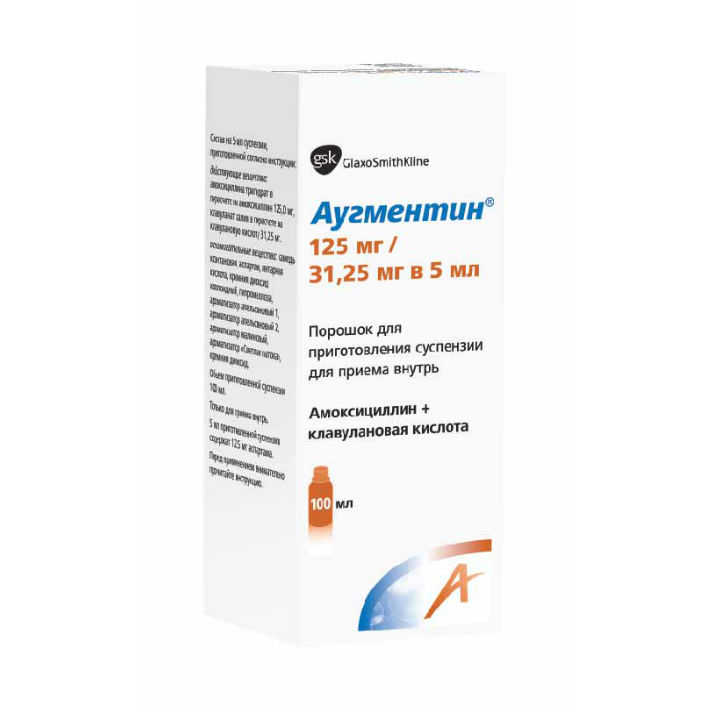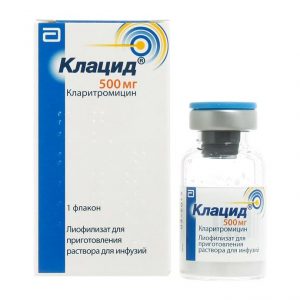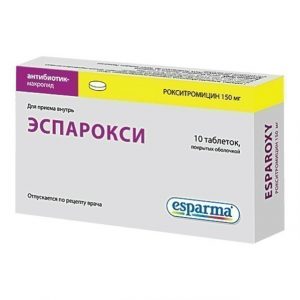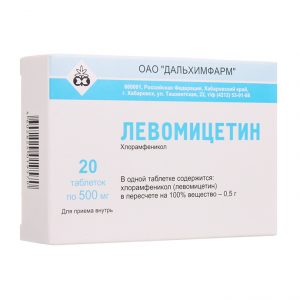Description
Release form
Powder for oral suspension.
Packing
Bottle 100 ml.
Pharmacological action
Amoxicillin is a semi-synthetic broad-spectrum antibiotic with activity against many gram-positive and gram-negative microorganisms. At the same time, amoxicillin is susceptible to destruction by β-lactamases, and therefore the spectrum of activity of amoxicillin does not extend to microorganisms that produce this enzyme.
Clavulanic acid, an -lactamase inhibitor structurally related to penicillins, has the ability to inactivate a wide range of -lactamases found in penicillin and cephalosporin resistant microorganisms.
Clavulanic acid has sufficient efficacy against plasmid -lactamases, which most often cause bacterial resistance, and is less effective against chromosomal -lactamases of type 1 that are not inhibited by clavulanic acid.
The presence of clavulanic acid in the Augmentin ® preparation protects amoxicillin from destruction by enzymes -lactamases, which allows to expand the antibacterial spectrum of amoxicillin.
The following is the in vitro combination activity of amoxicillin with clavulanic acid.
Bacteria commonly susceptible to the combination of amoxicillin with clavulanic acid
Gram-positive aerobes: Bacillus anthracis, Enterococcus faecalis, Listeria monocytogenes, Nocardia asteroides, Streptococcus pyogenes1,2, Streptococcus agalactiae. (other beta hemolytic streptococci) 1,2, Staphylococcus aureus (methicillin sensitive) 1, Staphylococcus saprophyticus (methicillin sensitive), Staphylococcus spp. (coagulase-negative, sensitive to methicillin).
Gram-negative aerobes: Bordetella pertussis, Haemophilus influenzae1, Helicobacter pylori, Moraxella catarrhalis1, Neisseria gonorrhoeae, Pasteurella multocida, Vibrio cholerae.
Other: Borrelia burgdorferi, Leptospira icterohaemorrhagiae, Treponema pallidum.
Gram-positive anaerobes: Clostridium spp., Peptococcus niger, Peplostreptococcus magnus, Peptostreptococcus micros, Peptostreptococcus spp.
Gram-negative anaerobes: Bacteroides fragilis, Bacteroides spp., Capnocytophaga spp., Eikenella corrodens, Fusobacterium nucleatum, Fusobacterium spp., Porphyromonas spp., Prevotella spp.
Bacteria for which the acquired resistance to a combination of amoxicillin with clavulanic acid is likely
Gram-positive aerobes: Corynebacterium spp., Enterococcus faecium, Streptococcus pneumoniae1,2, Streptococcus group Viridans2.
Bacteria having natural resistance to the combination of amoxicillin with clavulanic acid
Gram-negative aerobes: Acinetobacter spp, Citrobacter freundii, Enterobacter spp, Hafnia alvei, Legionella pneumophila, Morganella morganii, Providencia spp, Pseudomonas spp, Serratia spp, Stenotrophomonas maltophilia….. , Yersinia enterocolitica.
Others: Chlamydia pneumoniae, Chlamydia psittaci, Chlamydia spp., Coxiella burnetti, Mycoplasma spp.
1 – for these types of microorganisms, the clinical efficacy of a combination of amoxicillin with clavulanic acid has been demonstrated in clinical studies.
2 – strains of these types of bacteria do not produce -lactamases. Sensitivity with amoxicillin monotherapy suggests a similar sensitivity to the combination of amoxicillin with clavulanic acid.
Indications
Bacterial infections caused by sensitive microorganisms:
– Upper respiratory tract infection and upper respiratory organs (e.g., recurrent tonsillitis, sinusitis, otitis media), usually caused by Streptococcus pneumoniae, Haemophilus influenzae *, Moraxella catarrhalis *, Streptococcus pyogenes
– Lower respiratory tract infections: exacerbations of chronic bronchitis, lobar pneumonia, and bronchopneumonia, usually caused by Streptococcus pneumileraemexeraexemae tablets 250 mg / 125 mg)
– Urogenital tract infections: cystitis, urethritis, pyelonephritis, female genital infections, usually caused by species of the Enterobacteriaceae family (mainly Escherichia coli *), Staphylococcus saprophyticus and species of the genus Enterococcus
– Gonorrhea gonorrhea * (cro me tablets 250 mg / 125 mg)
– Infections of the skin and soft tissues, usually caused by Staphylococcus aureus *, Streptococcus pyogenes and species of the genus Bacteroides *
– Infections of bones and joints: osteomyelitis, usually caused by Staphylococcus aureus *, if long-term therapy with
is necessary – Odontogenic infections, for example, periodontitis, odontogenic, maxillary sinusitis, severe oral tumors 500 mg / 125 mg or 875 mg / 125 mg)
– Other mixed infections (e.g., septic abortion, postpartum sepsis, intra-abdominal sepsis) as part of step therapy (for 250 mg / 125 mg or 500 mg / 125 mg tablets, or 875 mg / 125 mg).
* – individual representatives of this type of microorganism, produce -lactamase, which makes them insensitive to amoxicillin.
Infections caused by microorganisms sensitive to amoxicillin can be treated with Augmentin ®, since amoxicillin is one of its active ingredients. Augmentin ® is also indicated for the treatment of mixed infections caused by microorganisms sensitive to amoxicillin, as well as microorganisms producing β-lactamase, sensitive to the combination of amoxicillin with clavulanic acid.
The sensitivity of bacteria to the combination of amoxicillin with clavulanic acid varies by region and over time. Where possible, local sensitivity data should be taken into account. If necessary, microbiological samples should be collected and analyzed for bacteriological sensitivity.
Contraindications
– Hypersensitivity to amoxicillin, clavulanic acid, other components of the drug, beta-lactam antibiotics (e.g. penicillins, cephalosporins) in history.
– Previous episodes of jaundice or impaired liver function with a history of amoxicillin and clavulanic acid.
– Children under 12 years of age and body weight less than 40 kg (for tablets 250 mg / 125 mg or 500 mg / 125 mg, or 875 mg / 125 mg).
– Children’s age up to 3 months (for a powder for the preparation of a suspension for oral administration, 200 mg / 28.5 mg and 400 mg / 57 mg).
– Impaired renal function (KK 30 ml / min) – (for tablets 875 mg / 125 mg, for powder for suspension for oral administration 200 mg / 28.5 mg and 400 mg / 57 mg).
– Phenylketonuria (for powder for oral suspension).
Caution: impaired liver function.
Use in pregnancy and lactation
In studies of reproductive function in animals, oral and parenteral administration of Augmentin ® did not cause teratogenic effects.
In a single study in women with premature rupture of the membranes, it was found that prophylactic drug therapy may be associated with an increased risk of necrotizing enterocolitis in newborns. Like all medicines, Augmentin ® is not recommended for use during pregnancy, unless the expected benefit to the mother outweighs the potential risk to the fetus.
Augmentin ® can be used while breastfeeding. With the exception of the possibility of developing diarrhea or candidiasis of the mucous membranes of the oral cavity associated with the penetration into the breast milk of trace amounts of the active substances of this drug, no other adverse effects were observed in infants who were breast-fed.
In case of adverse effects in breast-fed infants, breast-feeding should be discontinued.
Special instructions
Before starting treatment with Augmentin ®, a detailed medical history should be collected regarding previous hypersensitivity reactions to penicillins, cephalosporins or other allergens.
Serious, and sometimes fatal, hypersensitivity reactions (anaphylactic reactions) to penicillins are described. The risk of such reactions is highest in patients with a history of hypersensitivity reactions to penicillins. In case of an allergic reaction, it is necessary to discontinue treatment with Augmentin ® and begin appropriate alternative therapy. In case of serious hypersensitivity reactions, epinephrine should be administered immediately. It may also require oxygen therapy, iv administration of corticosteroids and airway management, including intubation.
Augmentin ® is not recommended in cases of suspected infectious mononucleosis, since in patients with this disease, amoxicillin can cause a measles-like rash, which makes it difficult to diagnose the disease.
Long-term treatment with Augmentin ® sometimes leads to excessive proliferation of insensitive microorganisms.
In general, Augmentin ® is well tolerated and has low toxicity characteristic of all penicillins.
During prolonged therapy with Augmentin ®, it is recommended to periodically evaluate renal, hepatic, and hematopoietic function.
In order to reduce the risk of side effects from the gastrointestinal tract, the drug should be taken at the beginning of a meal.
In patients receiving a combination of amoxicillin with clavulanic acid in conjunction with indirect (oral) anticoagulants, an increase in prothrombin time (increased MHO) has been reported in rare cases. With the joint appointment of indirect (oral) anticoagulants with a combination of amoxicillin with clavulanic acid, monitoring of the relevant indicators is necessary. To maintain the desired effect of oral anticoagulants, dose adjustment may be required.
In patients with impaired renal function, the dose of Augmentin ® should be reduced accordingly.
In patients with reduced diuresis, crystalluria development was reported in very rare cases, mainly with parenteral administration of the drug. During the administration of high doses of amoxicillin, it is recommended to take a sufficient amount of liquid and maintain adequate diuresis to reduce the likelihood of formation of amoxicillin crystals.
Ingestion of Augmentin ® leads to a high content of amoxicillin in the urine, which can lead to false-positive results in the determination of glucose in the urine (for example, a Benedict test, a Feling test). In this case, it is recommended to use the glucose oxidant method for determining the concentration of glucose in the urine.
Oral care helps prevent discoloration, since brushing your teeth is enough.
Tablets must be used within 30 days of opening the package of laminated aluminum foil.
Abuse and drug dependence
No drug dependence, addiction or euphoria reactions associated with the use of the drug Augmentin ® were observed.
Effect on driving ability and driving
Since the drug may cause dizziness, patients should be warned about precautions when driving or working with moving machinery.
Composition of
5 ml of the prepared suspension contain:
Active ingredient:
amoxicillin (in the form of trihydrate) 125 mg
clavulanic acid (in the form of potassium salt) 31.25 mg.
Excipients:
xanthan gum – 12.5 mg,
aspartame – 12.5 mg,
succinic acid – 0.84 mg,
silicon dioxide colloidal – 25 mg,
hypromellose – 150 mg,
orange flavor 1 – 15 mg,
orange flavor 2 – 11.25 mg,
raspberry flavor – 22.5 mg,
light syrup flavor – 23.75 mg,
silicon dioxide – 125 mg.
Dosage and administration
Dosage regimen is set individually depending on age, body weight, patient kidney function, as well as the severity of the infection. To optimally absorb and reduce possible side effects from the digestive system, Augmentin ® is recommended to be taken at the beginning of a meal. The minimum course of antibiotic therapy is 5 days.
Treatment should not be continued for more than 14 days without a review of the clinical situation.
If necessary, it is possible to carry out stepwise therapy (at the beginning of therapy, parenteral administration of the drug with subsequent transition to oral administration).
Adults and children over 12 years of age or weighing 40 kg or more
1 tablet 250 mg / 125 mg 3 times / day (for infections of mild to moderate severity), or 1 tablet 500 mg / 125 mg 3 times / day, or 1 tablet of 875 mg / 125 mg 2 times / day, or 11 ml of a suspension of 400 mg / 57 mg / 5 ml 2 times / day (which is equivalent to 1 tablet of 875 mg / 125 mg).
2 tablets 250 mg / 125 mg are not equivalent to 1 tablet 500 mg / 125 mg.
Children from 3 months to 12 years old with body weight less than 40 kg
The drug is prescribed in the form of a suspension for oral administration.
Dose calculation is carried out depending on age and body weight, indicated in mg / kg body weight / day (calculation according to amoxicillin) or in ml of suspension.
Multiplicity of suspension 125 mg / 31.25 mg in 5 ml – 3 times / day every 8 hours.
Multiplicity of suspension 200 mg / 28.5 mg in 5 ml or 400 mg / 57 mg 5 ml – 2 times / day every 12 hours
The recommended dosage regimen and frequency of administration are presented below:
Frequency of administration – 3 times / day, 4: 1 suspension (125 mg / 31.25 mg in 5 ml):
Low doses – 20 mg / kg / day .
High doses – 40 mg / kg / day.
Multiplicity of administration – 2 times / day, 7: 1 suspension (200 mg / 28.5 mg in 5 ml or 400 mg / 57 mg in 5 ml):
Low doses – 25 mg / kg / day.
High doses – 45 mg / kg / day.
Low doses of Augmentin ® are used to treat infections of the skin and soft tissues, as well as recurrent tonsillitis.
High doses of Augmentin ® are used to treat diseases such as otitis media, sinusitis, lower respiratory tract and urinary tract infections, and bone and joint infections.
Insufficient clinical data to recommend the use of Augmentin ® at a dose of more than 40 mg / kg / day in 3 divided doses (4: 1 suspension) in children under 2 years of age.
Children from birth to 3 months
Due to immaturity of the excretory function of the kidneys, the recommended dose of Augmentin ® (calculation for amoxicillin) is 30 mg / kg / day in 2 divided doses of 4: 1. The use of a 7: 1 suspension (200 mg / 28.5 mg in 5 ml or 400 mg / 57 mg in 5 ml) is not recommended in this population.
Premature birth
There are no recommendations regarding the dosage regimen.
Elderly patients
No dosage adjustment is required. In elderly patients with impaired renal function, the dose should be adjusted as follows for adults with impaired renal function.
Patients with impaired renal function
Dose adjustment is based on the maximum recommended dose of amoxicillin and is carried out taking into account QC values.
Adults
Tablets 250 mg + 125 mg or 500 mg + 125 mg:
KK> 30 ml / min – dosage adjustment is not required.
KK 10-30 ml / min – 1 tab. 250 mg + 125 mg 2 times / day or 1 tab. 500 mg + 125 mg (for mild to moderate infection) 2 times / day.
KK <10 ml / min - 1 tab. 250 mg + 125 mg 1 time / day or 1 tab. 500 mg + 125 mg (for mild to moderate infection) 1 time / day. Suspension 4: 1 (125 mg / 31.25 mg in 5 ml): KK> 30 ml / min – dosage adjustment is not required.
KK 10-30 ml / min – 15 mg / 3.75 mg / kg 2 times / day, maximum dose – 500 mg / 125 mg 2 times / day.
KK <10 ml / min - 15 mg / 3.75 mg / kg 1 time / day, the maximum daily dose is 500 mg / 125 mg. Tablets 875 mg + 125 mg and suspension 7: 1 (200 mg / 28, 5 mg in 5 ml or 400 mg / 57 mg in 5 ml) should be used only in patients with CC> 30 ml / min, and dose adjustment is not required.
In most cases, parenteral therapy should be preferred if possible.
Hemodialysis patients
Dose adjustments are based on the maximum recommended dose of amoxicillin: 2 tab. 250 mg / 125 mg in one dose every 24 hours, or 1 tab. 500 mg / 125 mg in one dose every 24 hours, or a suspension at a dose of 15 mg / 3.75 mg / kg 1 time / day.
Tablets: during the hemodialysis session, an additional 1 dose (one tablet) and another 1 dose (one tablet) at the end of the dialysis session (to compensate for the decrease in serum concentrations of amoxicillin and clavulanic acid).
Suspension: one additional dose of 15 mg / 3.75 mg / kg should be administered before the hemodialysis session. To restore the concentration of the active components of the drug Augmentin ® in the blood, a second additional dose of 15 mg / 3.75 mg / kg should be introduced after a hemodialysis session.
Patients with impaired liver function
Treatment is carried out with caution regularly monitor liver function. There is not enough data to correct the dosing regimen in this category of patients.
Rules for the preparation of suspension
A suspension is prepared immediately before the first use.
Suspension (125 mg / 31.25 mg in 5 ml): approximately 60 ml of boiled water cooled to room temperature should be added to the powder bottle, then close the bottle with a lid and shake until the powder is completely diluted, allow the bottle to stand for 5 minutes to ensure complete breeding. Then add water to the mark on the bottle and shake the bottle again. In total, about 92 ml of water is required to prepare the suspension. The bottle should be shaken well before each use. For accurate dosing of the drug should use a measuring cap, which must be washed well with water after each use. After dilution, the suspension should be stored for no more than 7 days in the refrigerator, but not frozen.
For children under 2 years of age, a measured single dose of a suspension of Augmentin ® can be diluted in half with water.
Suspension (200 mg / 28.5 mg in 5 ml or 400 mg / 57 mg in 5 ml): add approximately 40 ml of boiled water cooled to room temperature to the powder bottle, then close the bottle with a lid and shake until diluted powder allow the vial to stand for 5 minutes to ensure complete dilution. Then add water to the mark on the bottle and shake the bottle again. In total, about 64 ml of water is required to prepare the suspension. The bottle should be shaken well before each use. For accurate dosing of the drug, use a measuring cap or a dosing syringe, which must be washed well with water after each use. After dilution, the suspension should be stored for no more than 7 days in the refrigerator, but not frozen.
For children under 2 years of age, a measured single dose of a suspension of Augmentin ® can be diluted with water in a ratio of 1: 1.
Overdose
Symptoms: Gastrointestinal symptoms and impaired electrolyte balance may occur. Amoxicillin crystalluria has been described, in some cases leading to the development of renal failure.
Seizures may occur in patients with impaired renal function as well as in those receiving high doses of the drug.
Treatment: Gastrointestinal symptoms – symptomatic therapy, with special attention to normalization of water-electrolyte balance. In the event of an overdose, amoxicillin and clavulanic acid can be removed from the bloodstream by hemodialysis.
Prospective study results, which was conducted with the participation of 51 children at the toxicology center, showed that the introduction of amoxicillin at a dose of less than 250 mg / kg did not lead to significant clinical symptoms and did not require gastric lavage.
Storage conditions
The product should be stored in a dry, out of reach of children at a temperature not exceeding 25 ° C.
The reconstituted suspension should be stored in the refrigerator at 2 ° to 8 ° C.
Shelf life
Shelf life of tablets (250 mg + 125 mg) and (875 mg + 125 mg) – 2 years, tablets (500 mg + 125 mg) – 3 years.
The shelf life of the powder for the preparation of a suspension in an unopened bottle is 2 years.
The prepared suspension should be stored for 7 days.
Deystvuyushtee substance
amoxicillin, Klavulanovaya Chisloth
Terms and conditions
prescription
dosage form
oral suspension
GlaxoSmithKline, UK




